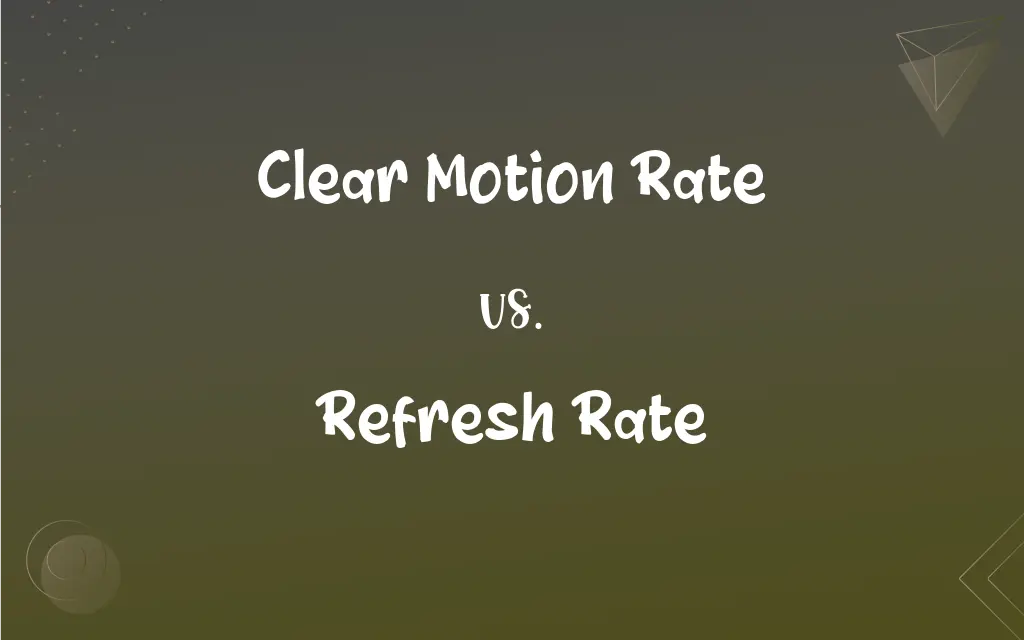Clear Motion Rate vs. Refresh Rate: What's the Difference?
Edited by Aimie Carlson || By Janet White || Published on February 26, 2024
Clear motion rate refers to a TV's perceived motion clarity, whereas refresh rate is the number of times a screen updates its image per second.

Key Differences
Clear motion rate (CMR) is a term often used by manufacturers to describe how well a TV can display fast-moving images. It factors in aspects beyond the physical screen refresh, such as image processor speed and backlight technology. In contrast, refresh rate is a more straightforward measurement, indicating how many times per second the image on a screen is refreshed, typically measured in Hertz (Hz). Higher refresh rates can lead to smoother motion in video content.
Clear motion rate is a manufacturer-specific metric, often used for marketing, it does not have a standardized measurement across different brands. It attempts to quantify the TV's ability to reduce motion blur. On the other hand, refresh rate is a standardized measure across all displays, denoting the frequency at which the image is updated. It's a critical factor for activities like gaming or watching fast-paced sports.
Clear motion rate can sometimes incorporate elements like backlight scanning or frame interpolation to enhance motion clarity, giving a higher perceived motion resolution than the actual refresh rate. Conversely, refresh rate refers specifically to the number of frames displayed per second. A higher refresh rate, such as 120 Hz, typically means smoother motion on-screen, especially noticeable in dynamic scenes.
The effectiveness of clear motion rate can vary significantly between TV models and brands, as it's not just a function of hardware but also of software algorithms. In contrast, refresh rate is a more reliable indicator of a screen's ability to handle motion, with higher rates (like 120Hz or 240Hz) generally providing a more fluid viewing experience, especially for high-speed content.
Clear motion rate is often perceived as a measure of a TV's overall performance in handling motion, it's not always reflective of the true capabilities of the display. Refresh rate, however, is a more objective measurement, directly impacting how smooth motion appears on the screen, regardless of the content being viewed.
ADVERTISEMENT
Comparison Chart
Definition
A manufacturer-specific metric indicating perceived motion clarity.
The number of times the screen updates its image per second.
Measurement
Not standardized, varies by manufacturer.
Standardized, typically measured in Hertz (Hz).
Influence
Factors in processor speed, backlight technology, and software.
Solely based on the display's ability to refresh the image.
Purpose
Intended to reduce motion blur and enhance clarity in fast-moving scenes.
Ensures smoothness of motion, critical for fast-paced content.
Reliability
Can be subjective and varies between brands and models.
A more objective and consistent measure across different screens.
ADVERTISEMENT
Clear Motion Rate and Refresh Rate Definitions
Clear Motion Rate
Reflects a combination of frame rate, image processor speed, and backlight technology.
The TV's clear motion rate enhances sports broadcasts, making every play look fluid.
Refresh Rate
A standard measure for the motion capability of screens, from TVs to monitors.
A refresh rate of 240Hz is overkill for most users, but it offers an ultra-smooth viewing experience.
Clear Motion Rate
A metric for assessing a TV's ability to display clear images in fast-moving scenes.
The high clear motion rate of this TV ensures that action movies look incredibly sharp.
Refresh Rate
Directly affects how fluidly motion is portrayed on a display.
This laptop's high refresh rate makes scrolling through websites a seamless experience.
Clear Motion Rate
A manufacturer-created value indicating how well a TV can handle motion blur.
Thanks to its superior clear motion rate, the soccer ball remains crisp and clear, even during fast kicks.
Refresh Rate
Indicates the number of times per second a display refreshes its image.
A higher refresh rate like 144Hz is ideal for competitive gaming due to smoother motion.
Clear Motion Rate
Represents the perceived clarity of moving images on a television.
This TV's clear motion rate makes the high-speed car chase scenes incredibly immersive.
Refresh Rate
A key spec for screens, impacting the smoothness of video playback and gaming.
The TV's 60Hz refresh rate is adequate for movies but may not be the best for fast-paced sports.
Clear Motion Rate
Often a blend of hardware capabilities and software algorithms to improve motion resolution.
The clear motion rate on this model is excellent, making video games appear more lifelike.
Refresh Rate
The frequency at which a screen updates its image, measured in Hertz.
With a 120Hz refresh rate, the animation on this monitor looks exceptionally smooth.
FAQs
Why is refresh rate important?
A higher refresh rate results in smoother motion, which is crucial for gaming and watching fast-paced content.
What is clear motion rate?
It's a TV manufacturer's rating for how well it displays fast-moving images, factoring in more than just refresh rate.
Is a higher clear motion rate better?
Generally, yes, as it indicates better motion clarity, but it's not standardized across brands.
Can clear motion rate be compared across different brands?
No, because it's not a standardized measure and varies by manufacturer.
What does refresh rate mean?
The number of times a screen refreshes its image per second, measured in Hertz (Hz).
What is a good clear motion rate for sports?
A higher value is preferred, but since it's not standardized, it's best to watch a sports demo on the TV.
Can refresh rate affect eye strain?
Yes, a lower refresh rate can cause more flicker, potentially leading to eye strain.
Does a higher refresh rate consume more power?
Potentially, as the screen has to update more frequently.
Do all TVs have a clear motion rate?
No, it's a term used by certain manufacturers and not a universal specification.
Is clear motion rate relevant for projectors?
It's less commonly used for projectors, which focus more on native frame rates.
Is refresh rate important for movie watching?
It's less crucial than for gaming, but a higher rate can still enhance the viewing experience.
Does refresh rate matter for a computer monitor?
Yes, especially for gaming or tasks requiring smooth motion.
Can clear motion rate be adjusted by the user?
No, it's a fixed characteristic determined by the TV's hardware and software.
Does a higher refresh rate mean a better picture?
For motion smoothness, yes, but it doesn’t directly relate to overall picture quality.
What is a typical refresh rate for TVs?
Commonly, 60Hz or 120Hz, but it can go higher for high-end models.
How does clear motion rate affect gaming?
It can improve the clarity of fast-moving objects, enhancing the gaming experience.
How can I find the clear motion rate of my TV?
Check the product specifications or manufacturer's website.
Is refresh rate the same as frame rate?
Not exactly. Frame rate is the content's frames per second, while refresh rate is how often the screen updates.
What is the ideal refresh rate for a gaming monitor?
120Hz or higher is typically preferred for a fluid gaming experience.
Does clear motion rate affect the viewing angle?
No, it’s more about motion clarity than viewing angles.
About Author
Written by
Janet WhiteJanet White has been an esteemed writer and blogger for Difference Wiki. Holding a Master's degree in Science and Medical Journalism from the prestigious Boston University, she has consistently demonstrated her expertise and passion for her field. When she's not immersed in her work, Janet relishes her time exercising, delving into a good book, and cherishing moments with friends and family.
Edited by
Aimie CarlsonAimie Carlson, holding a master's degree in English literature, is a fervent English language enthusiast. She lends her writing talents to Difference Wiki, a prominent website that specializes in comparisons, offering readers insightful analyses that both captivate and inform.
































































